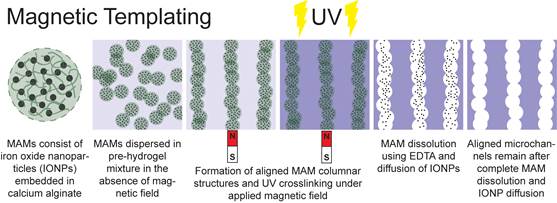Dr. Schmidt and Dr. Carlos Rinaldi (BME and CHE) were awarded a collaborative grant NIH 21 award on “Magnetically Templated Regeneration Scaffolds for Nerve Injury Repair”. Chris Lacko is one of the students in the Schmidt Lab working on this project. For these studies, the research team will develop and test magnetic templating (see figure) as an approach to obtain engineered regeneration scaffolds that could potentially replace decellularized nerve allografts and autografts in repairing 20-130 mm peripheral nerve injury gaps. Magnetic templating is unique and distinct from other approaches to templating aligned channels in engineered regeneration scaffolds in that is uses magnetic alginate microparticles (MAMs), consisting of biocompatible iron oxide nanoparticles embedded in a crosslinked calcium alginate matrix, to form aligned columnar structures under the action of an applied magnetic field and in a pre-hydrogel monomer mixture. The hydrogel is then crosslinked in the magnetic field, after which the MAMs are dissolved under mild conditions that are compatible with the presence of biomolecules and cells. As the MAMs dissolve, the iron oxide nanoparticles diffuse out of the hydrogel, leaving behind empty aligned channels that span the hydrogel and that have alignment, diameter, length, connectivity, and areal density that correlate with those of the MAM columnar structures. These properties can therefore be controlled through the concentration, diameter, and iron oxide nanoparticle content of the MAMs and the applied field conditions. Because MAMs can be obtained with diameters in the range of ~0.1 to ~10’s μm, it is possible to obtain aligned channels in the sought after diameter range of ~10 μm. These features make magnetic templating an innovative approach to obtaining engineered regeneration scaffolds consisting of biocompatible matrices with aligned tubular microstructures mimicking natural nerve tissue over clinically-relevant lengths and under processing conditions compatible with incorporation of chemical and biological cues.


